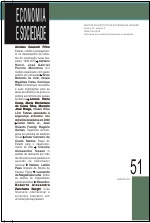Abstract
O artigo discute como a política fiscal, através dos gastos em educação, afeta a acumulação de capacidades e o nível de emprego. Desse modo, o gasto público pode afetar a produtividade e ter efeitos que vão além daqueles diretos sobre a demanda efetiva. O efeito sobre a produtividade deriva do fato de que parte do gasto público se destina à educação e ao treinamento dos trabalhadores. São discutidos os efeitos da política fiscal sobre o emprego, a produtividade e o crescimento, e as implicações de política do modelo. Neste artigo pretende-se analisar como a política fiscal, via gastos em educação, pode afetar a acumulação de capital humano e o nível de produtividade de um país e, consequentemente, alterar o nível de emprego e catalisar o crescimento econômico. A contribuição teórica proposta advém do fato de que a questão central é incluir uma nova dimensão, ou seja, a possibilidade de que o gasto público possa contribuir para os aumentos da produtividade. Isto é, o gasto do governo tem um efeito que vai além da demanda efetiva; ele pode afetar também a produtividade do trabalho, agora não mais constante. Neste modelo admitiremos que certa parcela do gasto público seja investida em educação. Dessa forma, se estabelece um vínculo entre política fiscal, educação e produtividade. A partir daí, serão obtidos novos resultados em termos dos níveis de emprego, salário e produto, e suas implicações de política poderão ser analisadas.
Abstract
This article discusses how fiscal policy, through the spending on education, affects the accumulation of capabilities and the levels of productivity. It is suggested the possibility that public spending may contribute to productivity increases, therefore having an effect that goes beyond its direct effect on effective demand. The effect on productivity comes from the investment of a share of total public spending in education and the training of workers. As a result, public spending gives rise to changes in employment levels, wages, productivity and growth, whose policy implications are analyzed.
Keywords: Fiscal policy; Productivity; Human capital; Education; Growth.
References
BLECKER, R. International competition, income distribution and economic growth, Cambridge Journal of Economics, v. 13, n. 3, p. 395-412, Sept. 1989.
BLECKER, R. Kaleckian macro models for open economies. In: DEPREZ, J.; HARVEY, J. T. (Ed.). Foundations of international economics: post Keynesian perspectives. London: Routledge, 1999. p. 116-149.
CARLIN, W.; SOSKICE, D. Macroeconomics and the wage bargain: a modern approach to employment, inflation and the exchange. New York: Oxford University Press, 1990.
CARLIN, W.; SOSKICE, D. Macroeconomics: imperfections, institutions, and policies. New York: Oxford University Press, 2006.
CASSETTI, M. Bargaining power, effective demand and technical progress: a kaleckian model of growth. Cambridge Journal of Economics, v. 27, n. 3, p. 449-464, 2003.
DUTT, A. K. Growth, distribution an uneven development. Cambridge, United Kingdom: Cambridge University Press, 1990.
LAYARD, R.; NICKELL, S.; JACKMAN, R. Macroeconomic performance and the labour market. New York: Oxford University Press, 1991.
LEDESMA, L. Accumulation, innovation and catching-up: an extended cumulative growth model. Cambridge Journal of Economics, v. 26, n. 2, p. 201-216, Mar. 2002.
LEWIS, H. G. Union relative wage effects: a survey. Chicago: University of Chicago Press, 1986.
LUCAS, R. On the mechanics of economic development. Journal of Monetary Economics, v. 22, n. 1, p. 3-42, 1988.
MANKIW, N. G.; ROMER, D.; WEIL, D. N. A contribution to the empirics of economics growth. Quarterly Journal of Economics, v. 107, n. 2, p. 407-437, May 1992.
MCCOMBIE, J.; THIRLWALL, A. P. Economic growth and the balance of payments constraint. London: St. Martins, 1994.
MCCOMBIE, J. Growth in an international context: a post-Keynesian view. In: DEPREZ, J.; HARVEY, J. T. (Ed.). Foundations of international economics: post Keynesian perspectives. London: Routledge, 1999.
SEN, A.; DUTT, A. K. Wage bargaining, imperfect competition and the markup: optimizing microfoundations. Economics Letters, v. 48, n. 1, p. 15-20, 1995.
SHONE, R. Economic dynamics: phase diagrams and their economic applications. Cambridge: Cambridge University Press, 1997.
STEINDL, J. Maturity and stagnation in American capitalism. Oxford: Basil Blackwell, 1952.
STEWART, M. B. Relative earnings and individual union membership in the United Kingdom. Economica, v. 50, n. 198, p. 111-126, May 1983. Disponível em: http://www.jstor.org/stable/2554055. Acesso em: 12 maio 2008.
TAKAYAMA, A. Analytical methods in economics. Michigan: The University of Michigan Press, 1993.
THIRLWALL, A. P. The balance of payments constraint as an explanation of international growth rates differences. Banca Nazionale del Lavoro Quarterly Review, p. 45-53, mar. 1979.
A Economia e Sociedade utiliza a licença do Creative Commons (CC), preservando assim, a integridade dos artigos em ambiente de acesso aberto.

